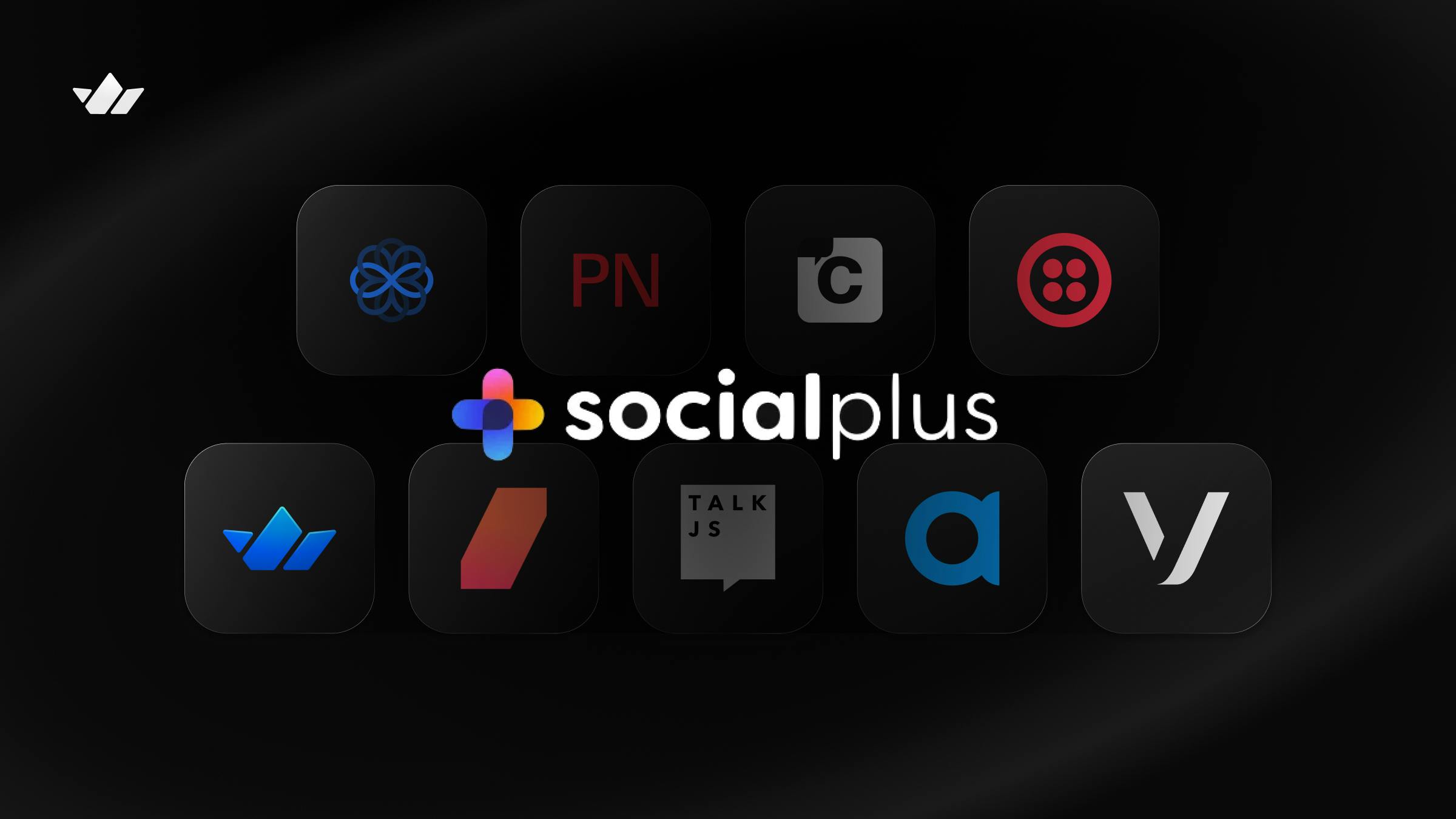From social platforms to marketplaces, many apps rely on real-time engagement to build loyalty. Social.plus (formerly Amity) positions itself as an all-in-one solution for chat, video, and activity feeds, making it a contender for social-driven apps, community platforms, and engagement-heavy products.
But Social.plus isn't the only option. A range of competitors offer similar functionality, often with stronger developer experiences, better scalability, or more robust features.
In this comparison, you'll find the top alternatives to Social.plus for building real-time communication features in your app. Discover how each compares and which platform is best suited for your use case.
Social.plus Overview
Social.plus is a bundled engagement platform that gives you three core building blocks in one place: in-app chat, real-time video, and activity feeds. It provides SDKs for iOS, Android, and web along with prebuilt UI components, an admin console, and moderation tools, so teams can ship community features quickly without stitching together multiple vendors.
Because Social.plus bundles capabilities, the evaluation hinges on how well its primitives integrate with your data model and UX, how far you can customize beyond the defaults, and whether the operational overhead (analytics, moderation, roles/permissions, push/notifications) matches your scale and compliance needs.
The sections below break down advantages, drawbacks, key features, and pricing to help you decide if the all-in-one approach fits your roadmap.
Advantages of Social.plus
-
All-in-one solution: Combines chat, video, activity feeds, and moderation in a single SDK, reducing the need for multiple vendors.
-
Faster time to market: Prebuilt UI kits and an admin dashboard help teams launch community features quickly without starting from scratch.
-
Cross-platform support: SDKs for iOS, Android, and web ensure consistency across devices and platforms.
-
Moderation tools included: Provides built-in controls for content review, user management, and safety, which are essential for public or social apps.
-
Flexible use cases: Suited for consumer social, marketplaces, edtech, events, and gaming---anywhere real-time engagement and community features boost retention.
-
Scalable backend services: Handles infrastructure for chat delivery, video streaming, and feed updates, so teams don't need to manage servers.
-
Engagement-first design: Features are structured to maximize interaction, with feeds, reactions, and messaging working together to drive ongoing participation.
Drawbacks of Social.plus
-
Limited customization: While prebuilt components accelerate development, teams with highly custom UX or complex workflows may find the SDKs restrictive.
-
Less mature developer experience: Documentation, sample apps, and SDK polish aren't always as strong as competitors.
-
Lack of pricing transparency: Social.plus does not publish pricing details on its website, requiring direct contact with sales to get a quote.
-
Ecosystem limitations: They have a smaller partner ecosystem and fewer third-party integrations compared to larger platforms.
-
Compliance gaps: While moderation tools are built in, enterprises in regulated industries may need stricter compliance certifications (e.g., HIPAA, DPF) not fully covered by Social.plus.
-
No global edge infrastructure: Social.plus does not advertise a global edge network for optimized routing, which may limit performance in geographically distributed apps
Main Social.plus Features
Social.plus' API offers a rich feature set, including the following:
-
In-app chat: Real-time 1:1, group, and community chat with support for rich media (images, videos, files, GIFs, stickers).
-
Activity feeds: Social feed components similar to Instagram or Facebook, including posts, reactions, stories, and comments to drive ongoing engagement.
-
Video features: APIs and SDKs for live video and video calls, allowing apps to support real-time interaction and broadcasting.
-
User & community management: Roles, permissions, and member management tools to control access and behavior within groups and feeds.
-
Built-in moderation: Admin dashboard and tools for removing content, banning users, and enforcing community guidelines.
-
Prebuilt UI kits: Ready-to-use components for chat, feeds, and video to accelerate development and ensure consistent UX.
-
Cross-platform SDKs: Android, iOS, Flutter, React, React Native, TypeScript, Angular, and Ionic SDKs to maintain feature parity across devices.
-
Push notifications & presence: Tools to keep users engaged with activity alerts, online/offline indicators, and typing states.
-
Analytics & insights: Basic analytics to track user engagement and community growth within the platform.
Social.plus Pricing
Social.plus does not publish pricing information on its website. To receive details on cost, prospective customers must contact the sales team directly. Pricing is provided on a custom-quote basis and is typically dependent on factors such as feature selection (chat, video, feeds, moderation), number of monthly active users, and expected usage volume.
What to Consider: Social.plus vs. Competitors
When evaluating Social.plus against alternatives, the decision often comes down to how well each platform supports your specific use case across chat, video, feeds, and moderation. Beyond feature checklists, important differences emerge in areas like developer experience, infrastructure, and pricing transparency.
Key considerations include:
-
Products offered: Some competitors only cover chat or video, while Social.plus combines chat, video, feeds, and moderation. Choosing a narrower vendor may require integrating multiple providers to achieve the same feature set.
-
Developer experience: Quality of documentation, sample apps, SDK stability, and ease of integration can significantly affect engineering time.
-
Customization: The level of control you have over UI, workflows, and data models varies widely across platforms.
-
Global infrastructure: Some vendors provide global edge networks for low-latency, high-reliability performance at scale; Social.plus does not advertise this.
-
Moderation & safety: Platforms differ in how deeply moderation tools are integrated and whether advanced features like AI-powered detection are available.
-
Compliance & certifications: Industries like healthcare and finance may require certifications (HIPAA, GDPR, SOC 2, etc.) that not all vendors support.
-
Pricing model: While Social.plus requires contacting sales for a quote, others offer published, usage-based pricing or free developer tiers.
Social.plus Versus Top Alternatives
-
Social.plus vs. Stream
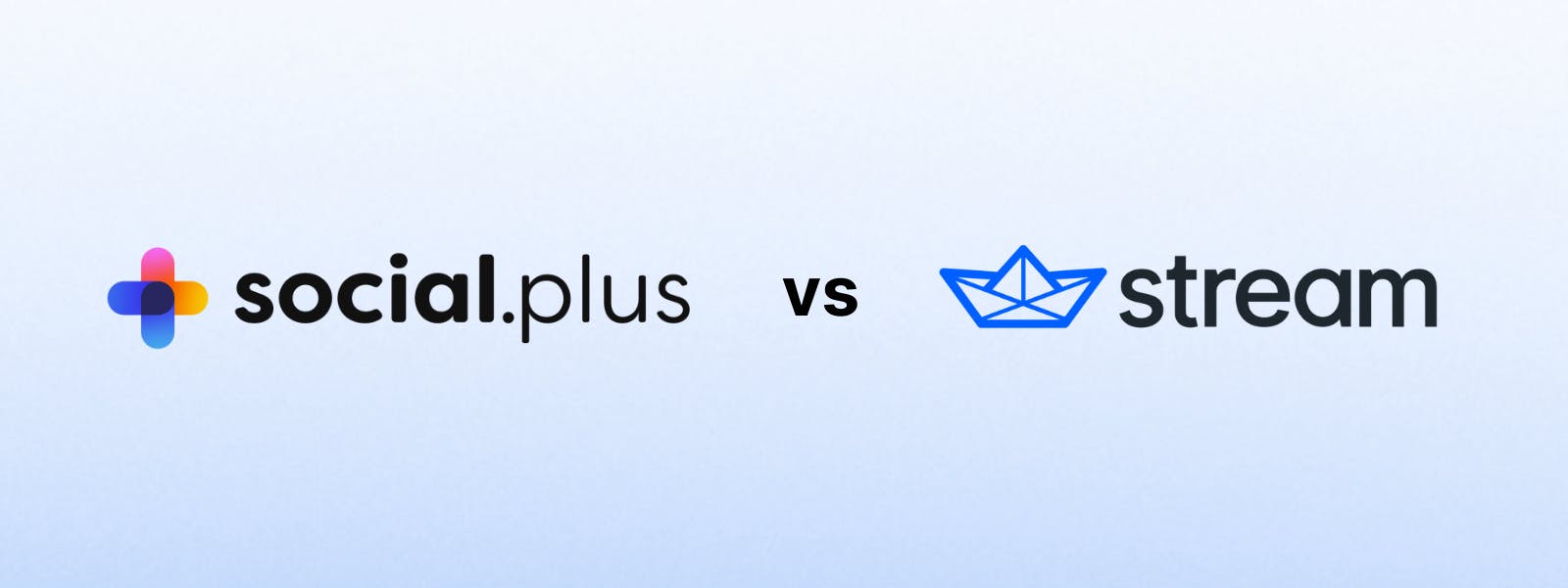
Social.plus and Stream both provide a bundled approach to community engagement, covering chat, video, activity feeds, and moderation. Social.plus positions itself as an all-in-one engagement SDK, while Stream emphasizes a global edge infrastructure and developer-first APIs that give teams deeper flexibility and scalability.
Stream Main Use Cases
Stream is often used by teams building:
-
Social platforms: Supporting feeds, communities, and user interactions that keep audiences active.
-
Virtual events: Enabling interactive experiences for webinars, live broadcasts, and hybrid gatherings.
-
Gaming: Driving fan engagement and player communication in fast-moving, high-traffic environments.
-
Telehealth and edtech: Providing secure and compliant infrastructure for patient care, online classrooms, and learning platforms.
-
Marketplaces: Facilitating safe communication and trust-building between buyers, sellers, and service providers.
-
Dating Apps: Helping users connect through secure, moderated interactions.
-
On-Demand Services: Supporting communication between providers and customers in delivery, mobility, and booking apps.
-
Collaboration Tools: Powering teamwork features in productivity, workplace, and community platforms.
-
AI Chatbot Integrations: Real-time infrastructure for conversational bots embedded into messaging flows.
Stream versus Social.plus
Here's how they differ:
-
Infrastructure & latency: Stream operates a global edge network designed for low latency and reliability worldwide. Social.plus does not advertise comparable infrastructure, which may affect performance for apps with geographically distributed users.
-
Moderation capabilities: Stream provides AI-powered moderation across chat, video, and feeds, with automated workflows, user-level actions (mute, ban, shadow-ban), and message-level controls. Social.plus includes built-in moderation dashboards and admin tools but offers fewer automation hooks and advanced enforcement options.
-
Customization & extensibility: Stream's APIs support custom fields, server-side enforcement, and event webhooks, enabling teams to build highly tailored workflows. Social.plus relies more on prebuilt components and fixed schemas, which accelerate time to launch but may be restrictive for complex use cases.
-
Production features: Stream includes advanced features such as backstage mode, live stream previews, participant management, and granular permissions. Social.plus supports live video and calls but emphasizes more basic broadcast and community tools.
Stream Pricing
Stream's Chat, Video & Audio, and Moderation are categorized by monthly active users, with advanced features unlocked at higher levels.
-
Start: Starts at $399/month for up to 10,000 MAU
-
Elevate: Starts at $599/month for up to 10,000 MAU
-
Enterprise: Talk to Sales
-
Pay-As-You-Go: Starts at $0.30/month for 1,000 participant minutes
-
Enterprise: Talk to Sales
-
Pay-As-You-Go: Starting at $2.00 for 1,000 messages, $4.00 for 1,000 images, $0.80 per minute of video, $4.00 for 1,000 frames
-
Enterprise: Talk to Sales
2. Social.plus vs. PubNub
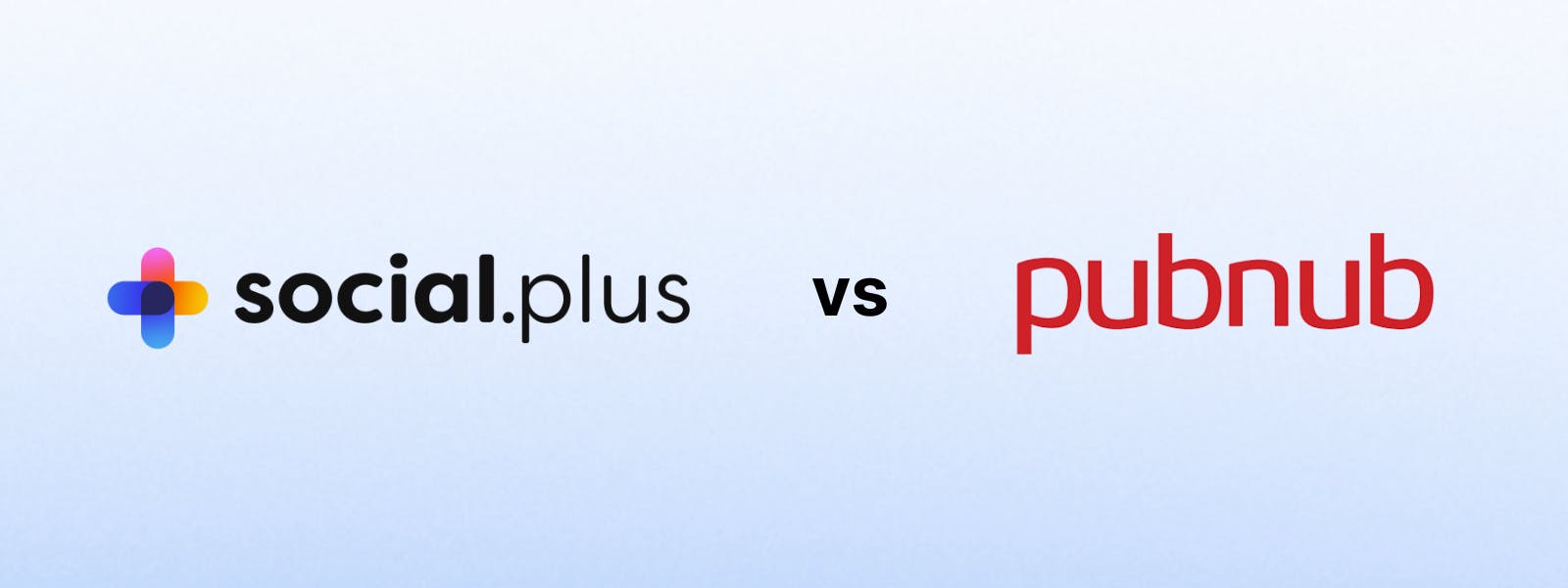
PubNub is a real-time communication platform best known for its messaging and data streaming APIs. It powers use cases like in-app chat, device signaling, presence, and real-time dashboards. Unlike Social.plus, PubNub does not provide video or activity feed features out of the box, so teams often use it specifically for chat or low-latency signaling in IoT and collaboration apps.
Social.plus versus PubNub
-
Product scope: PubNub primarily supports chat and real-time messaging, while Social.plus bundles chat, video, feeds, and moderation into one platform.
-
Infrastructure: PubNub operates a global data stream network with points of presence in multiple regions, enabling low-latency delivery worldwide. Social.plus does not advertise a similar global edge infrastructure.
-
Moderation: Social.plus includes built-in moderation dashboards and tools for managing users and content. PubNub provides raw messaging infrastructure, so moderation must be implemented separately.
-
Customization: PubNub gives developers low-level control over message routing, presence, and event handling. Social.plus provides higher-level SDKs and prebuilt components aimed at faster time to market.
-
Use cases: PubNub is often chosen for IoT, collaboration tools, and real-time dashboards, while Social.plus focuses more on community-driven apps like social platforms, marketplaces, and events.
PubNub Pricing
PubNub offers tiered pricing plans based on monthly active users and feature access.
-
Free: Up to 200 MAU or 1M transactions per month
-
Starter: From $98/month for 1,000 MAU
-
Pro: Contact Sales
3. Social.plus vs. CometChat
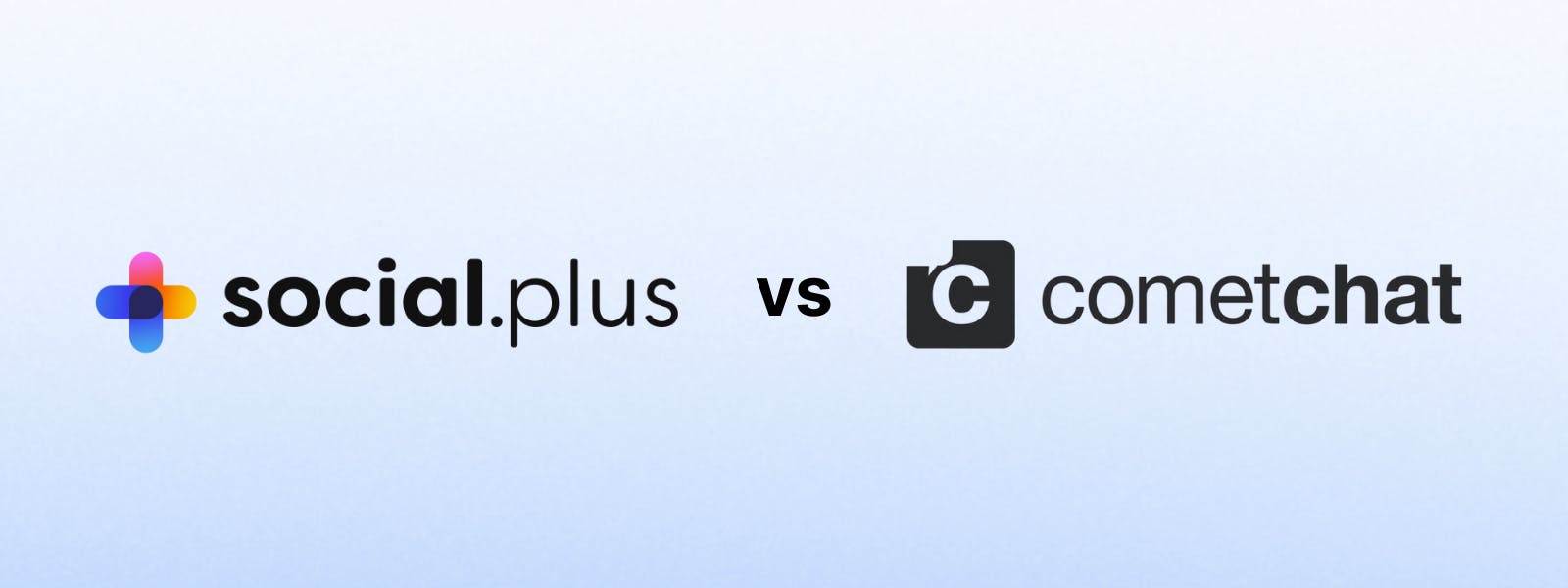
CometChat is a communications platform that provides chat, voice, and video APIs along with prebuilt UI kits. It is often used by developers who want to quickly add real-time messaging and calling capabilities to apps in industries like social networking, marketplaces, edtech, and healthcare. Unlike Social.plus, CometChat does not offer activity feeds as part of its product suite.
CometChat versus Social.plus
-
Product scope: CometChat supports chat and video, but does not include activity feeds. Social.plus bundles chat, video, feeds, and moderation in one platform.
-
UI kits vs. SDKs: CometChat emphasizes prebuilt UI kits that can be dropped into apps with minimal effort. Social.plus also offers prebuilt components but extends its coverage to feeds and community engagement.
-
Moderation: Social.plus provides a moderation dashboard and admin tools. CometChat offers a dual-engine moderation system featuring AI-powered, rule-based content filtering.
-
Customization: CometChat's UI kits speed up time to market but may limit deeper customization. Social.plus has similar trade-offs, though its feeds module makes it more of a turnkey "social app" solution.
-
Use cases: CometChat is frequently used in healthcare, marketplaces, and education apps where chat and video are critical. Social.plus positions itself more toward social platforms, creator communities, and apps that rely heavily on feeds.
CometChat Pricing
CometChat offers subscription-based pricing with tiers based on feature sets:
-
Free: Up to 100 MAU for testing and small projects
-
Basic: From $279/month for 10,000 MAU
-
Advanced: From $379/month for 10,000 MAU
-
Enterprise: From $999/month for 10,000 MAU
4. Social.plus vs. Agora
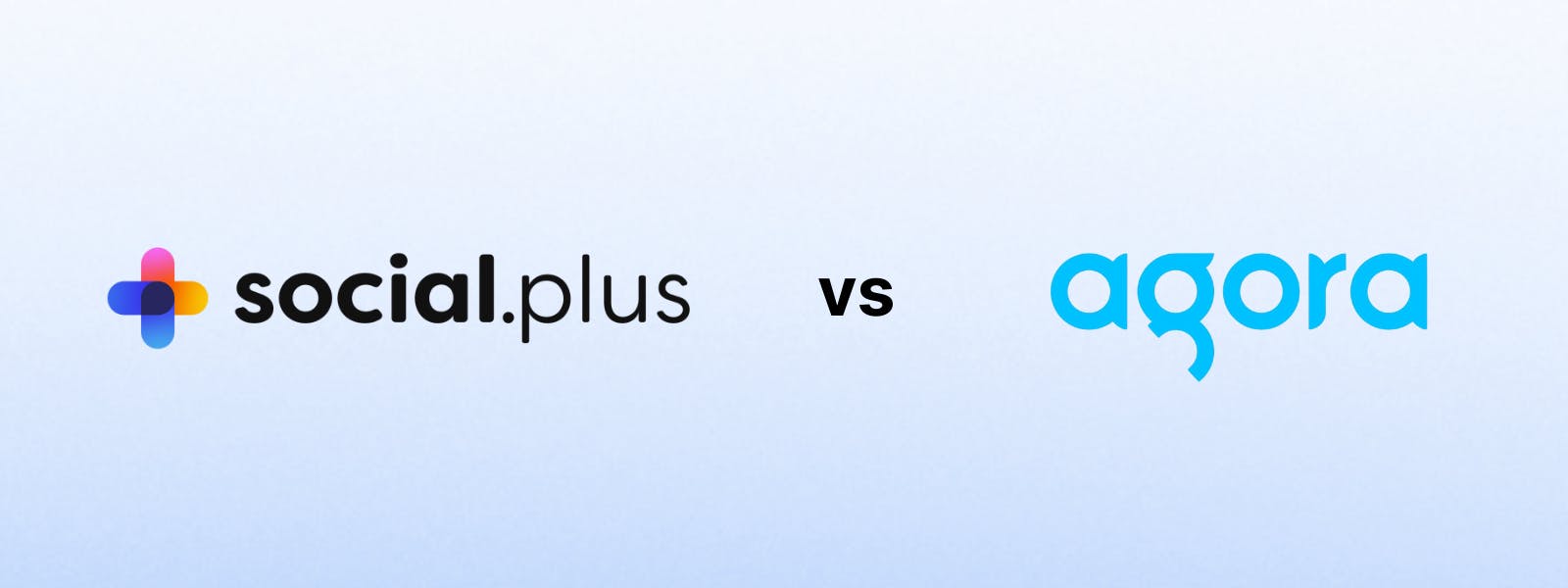
Agora is a real-time engagement platform best known for its video, voice, and live streaming APIs. It powers use cases ranging from video calls and webinars to interactive livestreams and social audio rooms. While Agora offers extensions like noise suppression, virtual backgrounds, and spatial audio, it does not include activity feeds as part of its core product suite.
Agora versus Social.plus
-
Product scope: Agora specializes in video, voice, and streaming. Social.plus provides a broader bundle with chat, video, feeds, and moderation.
-
Infrastructure: Agora operates a Software-Defined Real-Time Network (SD-RTN™) with global edge coverage for sub-second latency. Social.plus does not advertise a comparable global infrastructure.
-
Moderation: Social.plus includes built-in moderation dashboards and admin controls. Agora provides media enhancements and extensions but relies more on external tools or integrations for moderation.
-
Customization: Agora's SDKs allow for deep control over video and audio features, making it attractive for immersive or interactive use cases. Social.plus offers more packaged solutions that emphasize speed to market for community apps.
-
Use cases: Agora is frequently used in livestreaming, video conferencing, and entertainment apps. Social.plus positions itself toward apps where video is combined with chat, feeds, and moderation to create community-driven engagement.
Agora Pricing
Agora offers pay-as-you-go pricing based on usage:
-
Voice Calling: From $0.99 per 1,000 minutes
-
Video Calling: From $3.99 per 1,000 minutes
-
Interactive Live Streaming: From $0.99 per 1,000 minutes
-
Chat: From $345 per month
-
Enterprise Plans: Contact Sales for custom pricing and volume discounts
5. Social.plus vs. TalkJS
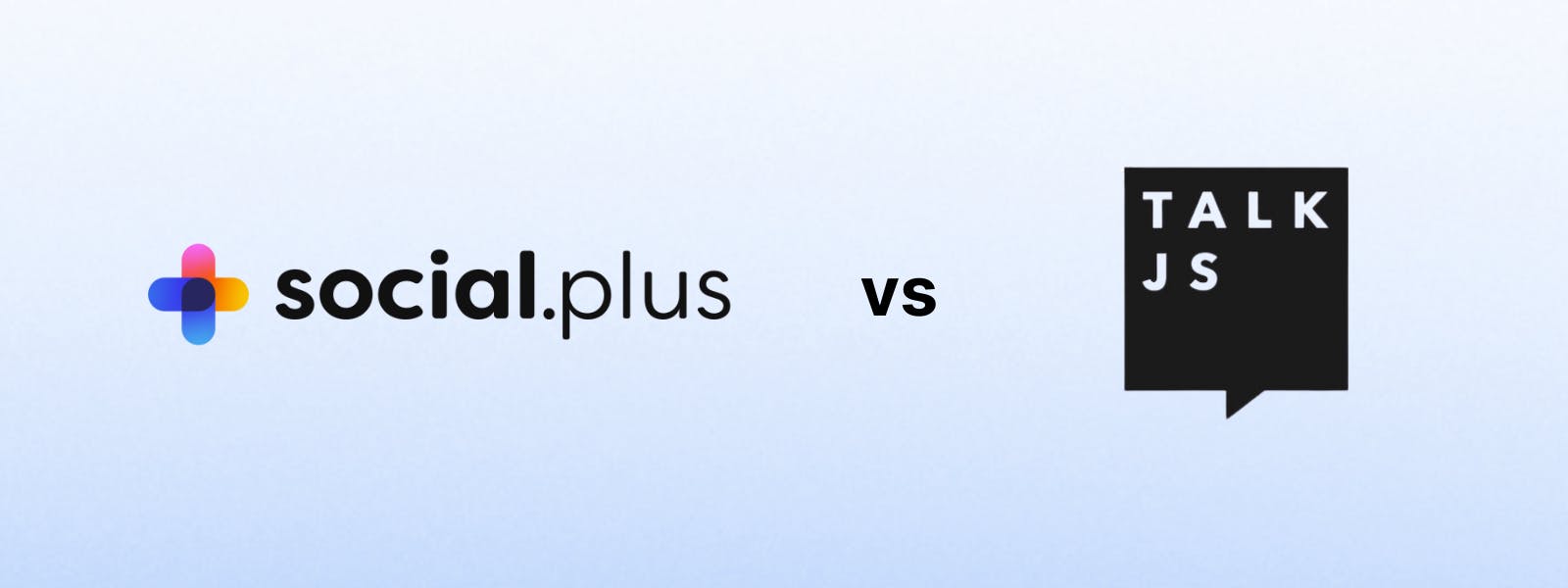
TalkJS is a developer tool focused on in-app chat and messaging. It provides prebuilt chat UIs, an admin panel, and REST APIs designed to help teams add 1:1, group, or marketplace messaging quickly. Unlike Social.plus, TalkJS does not offer video or activity feeds, making it a narrower solution focused purely on chat.
TalkJS versus Social.plus
-
Product scope: TalkJS provides chat only, with prebuilt components for messaging interfaces. Social.plus includes chat, video, feeds, and moderation as an all-in-one package.
-
UI approach: TalkJS emphasizes embedding ready-made chat UIs that require minimal development effort. Social.plus offers prebuilt components as well, but also covers feeds and live video experiences.
-
Moderation: Social.plus includes dashboards and admin tools for managing communities. TalkJS supports moderation features like blocking, deleting, and reporting, but its scope is limited to chat.
-
Customization: TalkJS allows customization of its prebuilt chat UI through themes and configuration. Social.plus supports broader customization across chat, video, and feeds.
-
Use cases: TalkJS is often chosen for marketplaces, customer-to-customer messaging, and SaaS apps where chat is a feature. Social.plus is aimed at social platforms, creator apps, and communities where multiple engagement types are needed.
TalkJS Pricing
TalkJS offers subscription-based pricing based on monthly active users:
-
Free: Up to 100 monthly active users
-
Basic: From $279/month for 10,000 monthly active users
-
Growth: From $569/month for 25,000 monthly active users
-
Enterprise: Contact Sales for higher usage and advanced support
6. Social.plus vs. Twilio

Twilio is a cloud communications platform that offers a broad portfolio of APIs, including SMS, voice, video, and messaging. Its Twilio Conversations and Twilio Video products allow developers to add chat and video into their apps, while the wider Twilio ecosystem covers telephony, authentication, and contact center solutions. Unlike Social.plus, Twilio does not provide activity feeds as part of its offering.
Twilio versus Social.plus
-
Product scope: Twilio provides APIs for chat, video, voice, and SMS, but does not include activity feeds. Social.plus bundles chat, video, feeds, and moderation into one platform.
-
Ecosystem breadth: Twilio is part of a large suite of communications tools that includes SMS, email (SendGrid), and authentication. Social.plus is more narrowly focused on in-app community engagement.
-
Infrastructure: Twilio operates a global cloud communications network for reliable delivery. Social.plus does not highlight a global edge infrastructure for low-latency routing.
-
Moderation: Social.plus includes built-in dashboards for moderation and community management. Twilio provides messaging APIs but does not include comparable native moderation features, requiring developers to implement their own.
-
Customization: Twilio APIs give deep flexibility for integrating communications into a custom workflow. Social.plus offers prebuilt components for faster setup across chat, video, and feeds.
-
Use cases: Twilio is often chosen for enterprise communications, customer support, and telephony-heavy apps. Social.plus is positioned toward social and community-driven apps where feeds and moderation are central.
Twilio Pricing
Twilio pricing is usage-based and varies by product:
-
Twilio Conversations (Chat): From $0.05 per active user per month
-
Twilio Video: From $0.0004 per participant minute
-
Twilio Programmable Voice: Usage-based, starting at $0.0085 per minute (inbound, U.S.)
-
Enterprise Plans: Contact Sales for high-volume pricing and custom agreements
7. Social.plus vs. 100ms
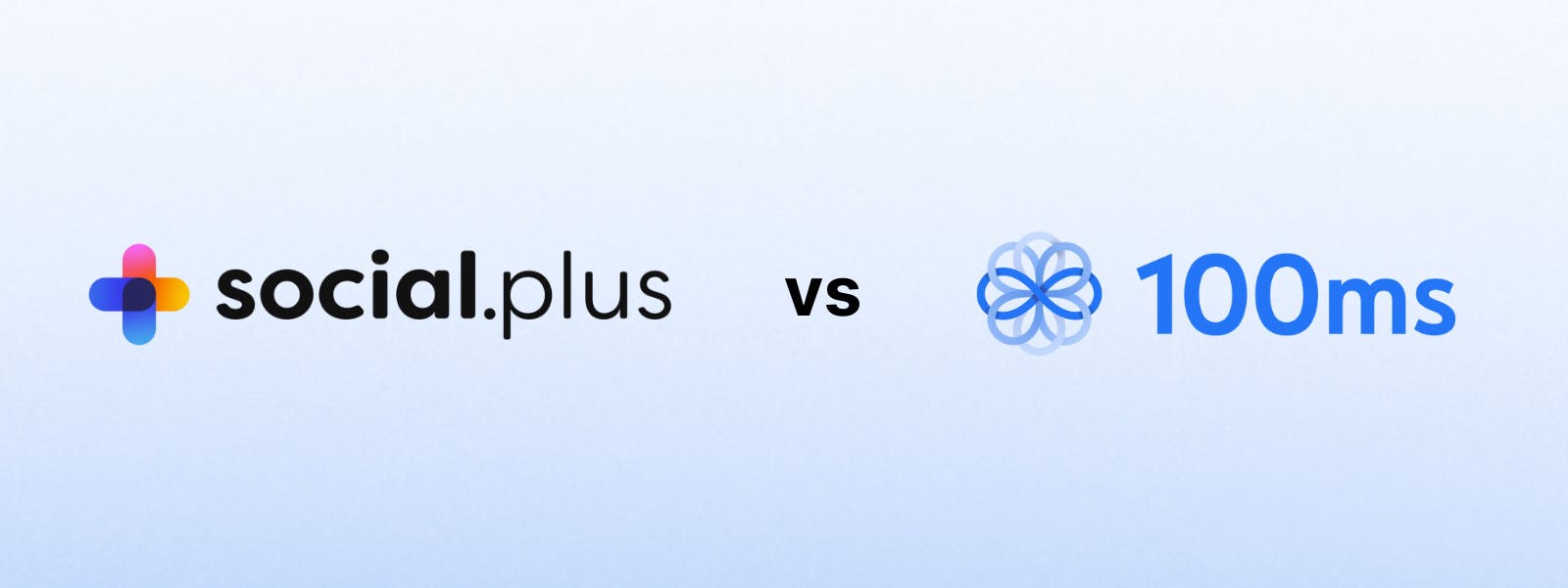
100ms is a real-time video and audio platform that provides APIs and SDKs for video calls, livestreaming, and audio rooms. It is designed with a developer-first approach, offering prebuilt UI components, event-driven APIs, and strong documentation. Unlike Social.plus, 100ms does not provide activity feeds, and its primary focus is video and audio experiences.
100ms versus Social.plus
-
Product scope: 100ms specializes in video and audio with SDKs for calls, livestreams, and audio rooms. Social.plus includes chat, video, feeds, and moderation in a single platform.
-
Infrastructure: 100ms operates a global infrastructure with adaptive bitrate streaming and fallback mechanisms for video quality. Social.plus does not advertise similar global infrastructure for low-latency delivery.
-
Moderation: Social.plus provides built-in moderation dashboards and admin tools for managing content and users. 100ms offers features like role-based permissions (host, co-host, listener) and API hooks for custom moderation, but fewer native moderation dashboards.
-
Customization: 100ms provides granular APIs and flexible role management for tailoring video and audio workflows. Social.plus offers broader but less granular customization across its bundled features.
-
Use cases: 100ms is commonly chosen for virtual events, classrooms, webinars, and social audio rooms. Social.plus focuses on community platforms, marketplaces, and apps where feeds, chat, and video combine to drive engagement.
100ms Pricing
100ms offers transparent, usage-based pricing:
-
Free: 10,000 conferencing minutes and 10,000 streaming minutes per month, plus limited recording and transcription.
-
Pay-As-You-Grow: From $0.004 per participant minute for conferencing and $0.0012 per viewer minute for live streaming, with additional costs for recording and transcription.
-
Custom: Discounted pricing available for high-volume usage (over $5,000/month) and migration incentives (e.g., up to 50% off for teams moving from Zoom).
8. Social.plus vs. Daily
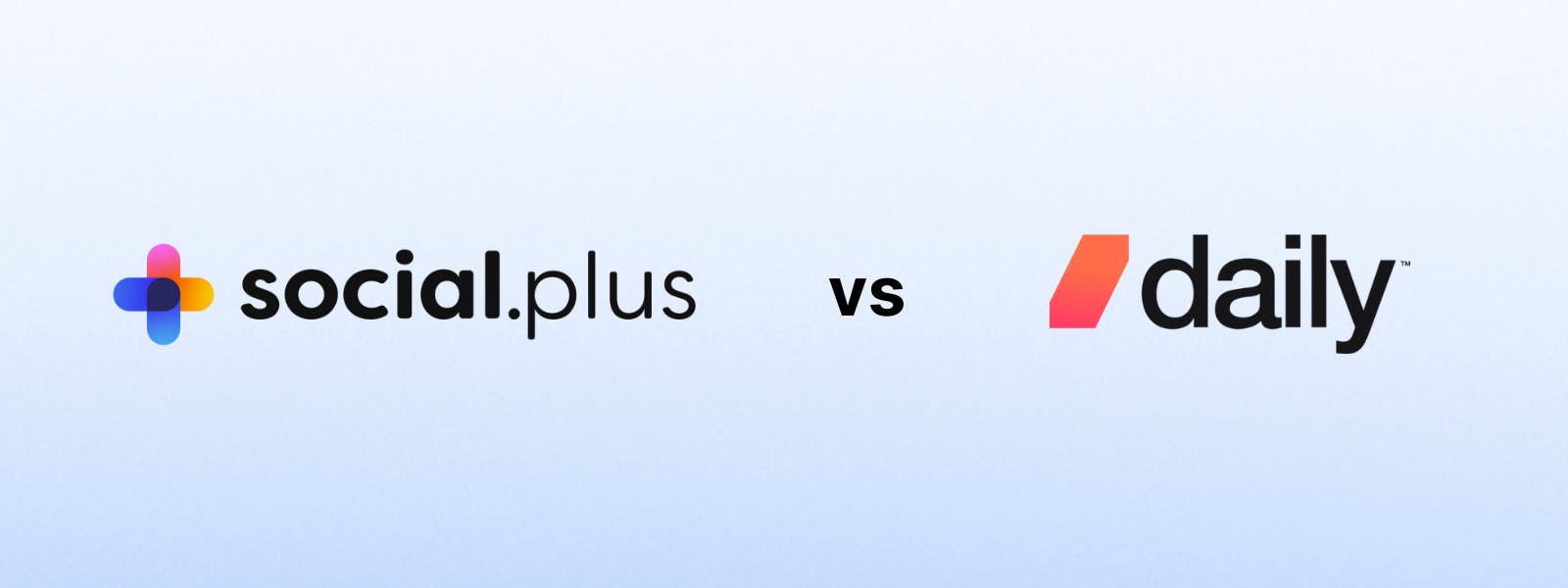
Daily is a WebRTC-based video API platform built for video calls, livestreaming, and recording. It is known for strong compliance support (SOC 2 Type 2, HIPAA, EU-U.S. Data Privacy Framework) and advanced features like programmable recording layouts and live transcription. Unlike Social.plus, Daily does not provide chat or activity feeds, focusing instead on high-quality video infrastructure.
Daily versus Social.plus
-
Product scope: Daily specializes in video calls, livestreaming, and recording. Social.plus includes chat, video, feeds, and moderation.
-
Compliance: Daily is SOC 2 Type 2 compliant, HIPAA-ready, and certified under the EU-U.S. Data Privacy Framework. Social.plus does not publicly list equivalent compliance certifications.
-
Infrastructure: Daily allows customers to select data center regions for residency requirements. Social.plus does not advertise region selection or global edge routing.
-
Moderation: Social.plus includes moderation dashboards and tools across chat, video, and feeds. Daily focuses on video APIs and relies on developers to build custom moderation workflows.
-
Customization: Daily provides APIs for custom layouts, programmable recording, and advanced transcription. Social.plus emphasizes prebuilt components across multiple engagement surfaces.
-
Use cases: Daily is commonly used for telehealth, edtech, virtual events, and collaboration apps where compliance and recording are priorities. Social.plus positions itself toward social platforms, communities, and apps combining feeds, chat, and video.
Daily Pricing
Daily offers transparent usage-based pricing:
-
Free: 10,000 minutes per month for video and audio calls
-
Pay-As-You-Go: From $0.004 per participant minute for video calls; additional charges for recording and transcription
-
Enterprise: Custom pricing and support for high-volume usage
9. Social.plus vs. Vonage

Vonage (formerly TokBox) offers a Video API as part of its broader communications portfolio, which also includes SMS, voice, and contact center solutions. Its video SDKs allow developers to add conferencing and livestreaming into apps, but unlike Social.plus, Vonage does not include activity feeds. Many enterprises choose Vonage when they want to consolidate communications vendors under a single contract.
Vonage versus Social.plus
-
Product scope: Vonage provides APIs for video, voice, and messaging, but does not include feeds. Social.plus combines chat, video, feeds, and moderation.
-
Ecosystem breadth: Vonage offers a wide suite of communications tools (SMS, telephony, contact center), while Social.plus focuses exclusively on in-app community engagement.
-
Infrastructure: Vonage's video SDKs are reliable but often considered less modern compared to newer entrants. Social.plus emphasizes prebuilt components but does not advertise global edge routing.
-
Moderation: Social.plus includes native dashboards and admin controls for user and content moderation. Vonage does not provide comparable built-in moderation, requiring additional tooling or integrations.
-
Customization: Vonage's video APIs provide flexibility but can require more development work and documentation review. Social.plus aims for quicker setup with prebuilt UI and bundled features.
-
Use cases: Vonage is often used by enterprises needing SMS, telephony, and video together. Social.plus is targeted at social apps, creator communities, and engagement-heavy platforms.
Vonage Pricing
Vonage Video API pricing is usage-based:
-
Messages API: From $0.00121 per message
-
Conversation API: From $0.0008 per custom event post
-
Video API: From $0.0041 per minute
-
Enterprise Plans: Contact Sales for high-volume usage or bundled communications solutions
Alternatives Comparison Post
| Provider | Chat | Video | Feeds | Moderation | Global Edge Infrastructure | Pricing Transparency |
|---|---|---|---|---|---|---|
| Social.plus | ✅ | ✅ | ✅ | ✅ (dashboards & admin tools) | ❌ Not advertised | ❌ Sales contact required |
| Stream | ✅ | ✅ | ✅ | ✅ (AI + dashboards) | ✅ Global edge network | ✅ Published |
| PubNub | ✅ | ❌ | ❌ | ⚠️ (developer-built) | ✅ Global data stream network | ✅ Published |
| CometChat | ✅ | ✅ | ❌ | ✅ (AI + dashboards) | ✅ Global edge network | ✅ Published |
| Agora | ⚠️ Limited | ✅ | ❌ | ⚠️ (extensions, external tools) | ✅ SD-RTN™ global edge | ✅ Published |
| TalkJS | ✅ | ❌ | ❌ | ✅ Basic chat moderation only | ❌ Not advertised | ✅ Published |
| Twilio | ✅ | ✅ | ❌ | ❌ (requires custom implementation) | ✅ Global comms infra | ✅ Published |
| 100ms | ❌ | ✅ | ❌ | ⚠️ Role-based + API hooks | ✅ Global infra | ✅ Published |
| Daily | ❌ | ✅ | ❌ | ❌ (requires custom workflows) | ✅ Region selection | ✅ Published |
| Vonage | ✅ | ✅ | ❌ | ❌ (requires integrations) | ✅ Global comms infra | ✅ Published |
Is Social.plus Right For You?
Social.plus offers an all-in-one approach to in-app engagement, bundling chat, video, feeds, and moderation in a single SDK. This makes it appealing for teams that want to move quickly without stitching together multiple vendors.
However, competitors differ in important ways: some emphasize global infrastructure for low-latency delivery, others excel at advanced moderation, and some focus on developer-first APIs with transparent pricing. If your app requires scale, deep customization, or compliance, platforms like Stream, Daily, or 100ms may be stronger fits. If your priority is chat-only, providers like TalkJS or PubNub might meet your needs with less overhead.
Most providers offer free tiers or trial plans, making it possible to test integrations before committing. Taking advantage of these options is the best way to evaluate fit for your app's unique requirements.
The right choice depends on your product's roadmap. Carefully weigh feature coverage, moderation depth, infrastructure, and pricing transparency before committing to a long-term platform.

